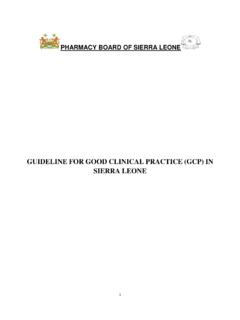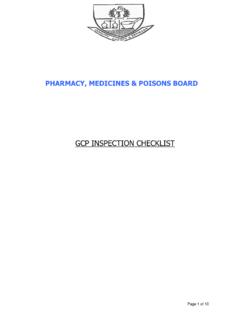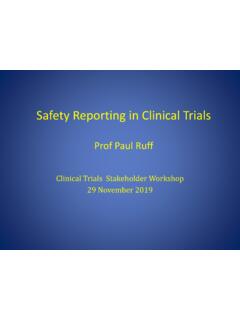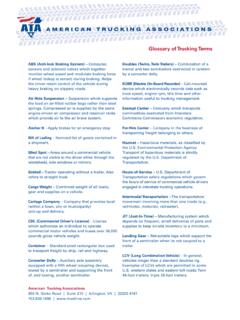Transcription of REGULATORY REQUIREMENTS ON STORAGE AND EXPORT …
1 PHARMACY, MEDICINES & POISONS BOARD REGULATORY REQUIREMENTS ON STORAGE AND EXPORT OF SAMPLES / SPECIMENS COLLECTED FROM PARTICIPANTS / CLINICAL TRIAL SUBJECTS DURING CLINICAL TRIALS FOR TESTING 1 Table of Contents Page 1 Introduction 4 2 Scope 6 3 Responsibilities of the Sponsor, Carrier and Receiver 6 4 Abbreviations, Definitions 7 5 Classification of infectious substances and diagnostic specimens 7 Infectious substance, Category A 7 Infectious substance, Category B 8 Cultures 9 Trial participant specimens 9 Biological products 9 Human material 9 Genetically modified micro-organisms and organisms 9 Exceptions 9 6 Labelling and Packaging for STORAGE and EXPORT 10 General preparation of shipments for transport 10 Basic triple packaging system 11 Packaging for Exempt Patient Specimens 11 Packaging, labelling and documentation REQUIREMENTS for infectious substances in Category A (UN 2814 04 UN 2900)
2 11 Packaging 11 Marking 12 Labelling 12 Documentation 13 Packaging, labelling and documentation REQUIREMENTS for infectious substances in Category B (Clinical Specimens, Diagnostic Specimens, Biological Substances) (UN 3373) 13 Packaging 13 Marking 14 Documentation 14 Over packs 14 Refrigerants 14 Infectious Substance and Diagnostic Specimen Comparison 15 7 General Acceptable Packaging 16 Watertight Primary Receptacles 16 Watertight Secondary Receptacles 16 Absorbent Material 17 Sturdy Outer Packaging 17 Unacceptable Outer Packaging 18 2 Table of Contents Page 8 References 18 Annexes Annex 1 Check-list 19 Annex 2 - Indicative Examples of Infectious Substances included in Category A in any form unless otherwise indicated 21 Annex 3 ICAO Classification Flowchart 23 Annex 4 General Classification Flowchart
3 24 Annex 5 - ICAO Classification Scenarios 25 Annex 6 Example of Packing and Marking for Exempt Human Specimens for Exempt Animal Specimens 26 Annex 7 Packing, Marking and Labelling of Category A Infectious Substances 27 Annex 8 - Package specification marking for Category A infectious substances (UN 2814 and UN 2900) 28 Annex 9 Example of Packing and Marking for Category B Infectious Substances 29 3 1 Introduction Samples or specimens collected from participants during clinical trials are often not tested at the clinical trial site and may have to be sent nationally or internationally to another testing laboratory. Postal, airline and other transport industry personnel have concerns about the possibility of becoming infected as the result of exposure to infectious micro-organisms that may escape from broken, leaking or improperly packaged material. The packaging of infectious substances for transport must therefore be designed to minimize the potential for damage during transport.
4 In addition, the packaging must ensure the integrity of the materials and so, in turn, timely and accurate processing of specimens. Transportation of specimens is subject to regulation by the International Air Transport Association (IATA), which is stringent in its REQUIREMENTS for packaging, declaration and paperwork. Informed consent is required from the clinical trial subject or his/her legal representative or guardian whenever a new sample is taken wholly or partly for use in research. Donors should understand what the sample is to be used for and how the results of the research might impact on their interests. Consent must also be obtained for STORAGE and potential future use of samples. In some clinical trials, clinical specimens may be tested initially at local laboratories, and any isolates that are recovered will then be sent to a central laboratory to confirm the identity of suspected pathogens and for antibiotic susceptibility testing.
5 For example, in a clinical study involving skin infections, an investigator may be concerned with microbial testing only for Staphylococcus aureus as the primary target pathogen. If this pathogen were recovered from an initial specimen, it might be sent to a central laboratory for confirmation and additional testing. Ensuring that clinical samples reach their destination safely, securely, and at the right temperature is a critical element in the clinical trial process. Cold chain or temperature control is playing a greater role in clinical logistics, as the process of transporting human clinical trial samples and investigational drugs becomes increasingly complex. If clinical trials are to come in on time and on budget, it is critical for all parties associated with the transportation of biological substances - from the REGULATORY agencies overseeing transportation practices to the lab personnel, couriers and airline staff that handle the shipments - become fully familiar with and adhere to the proper packing and shipping practices.
6 Once samples/specimens are taken from clinical trial subjects they need to arrive in central laboratories in a defined transit time and in suitable packaging. Many samples have to be tested immediately and remain either frozen, or at refrigerated temperatures. Delays in transit times or incorrect STORAGE conditions may lead to the loss of a sample and will negatively impact on the trial results. Some types of transport media are better than others for particular applications. For instance, some media are designed for maintaining fastidious organisms. In clinical trials, the choice of transport medium depends in part on what target pathogens need to be recovered and also on the nature of the specimen being collected. Three major devices are employed to maintain viability of organisms during their shipment (Table 1). In clinical trials, participants from many different countries are often enrolled in studies, and specimens collected from these participants are shipped over vast distances.
7 Under such circumstances, it is imperative that the viability of organisms in the specimen be maintained until they reach the central laboratory. Deciding whether to ship specimens that are frozen, refrigerated , or kept at ambient temperatures depends on a number of factors, including the 4 type of study; countries where it is being performed; the local, national, and international shipping regulations that apply; the time of transit; and the target pathogens being sought. Table 1 Major devices used to maintain viability of organisms Device Shipping temperature Disadvantages Refrigeration (with gel packs) 2 8 C Weight and cost Freezing (with dry ice) approx -20 C Weight and cost Ambient (no coolant) 20 25 C Selective agents may have to be added to limit bacterial competition In recent years, clinical laboratories have shifted into a system in which many peripheral laboratories conduct only tests that can be completed the same day, while most specimens requiring culture and analysis are performed by a smaller set of core laboratories to which specimens are shipped.
8 This change has led to increased reliance on the use of transport media to maintain the viability of pathogens during transit, which may take several days depending on the distances between the peripheral and core laboratories. In clinical trials microbiology as well as in routine clinical testing, properly collecting specimens and transporting them under appropriate conditions is critically important for maintaining microbial viability. International regulations The international regulations for the transport of infectious substances by any mode of transport are based upon the Recommendations made by the Committee of Experts on the Transport of Dangerous Goods (UNCETDG), a committee of the United Nations Economic and Social Council. The Recommendations are presented in the form of Model Regulations. The United Nations Model Regulations are reflected in international law through international modal agreements.
9 Air The Technical Instructions for the Safe Transport of Dangerous Goods by Air published by the International Civil Aviation Organization (ICAO) are the legally binding international regulations. The International Air Transport Association (IATA) publishes Dangerous Goods Regulations (DGR) that incorporate the ICAO provisions and may add further restrictions. The ICAO rules apply on all international flights. For national flights, flights within one country, national civil aviation authorities apply national legislation. This is normally based on the ICAO provisions, but may incorporate variations. State and operator variations are published in the ICAO Technical Instructions and in the IATA Dangerous Goods Regulations. rail Regulations concerning the International Carriage of Dangerous Goods by rail (RID) apply to countries in Europe, the Middle East and North Africa.
10 RID also applies to domestic transport in the 25 countries of the European Union through Council Directive 96/49/EC. Road The European Agreement concerning the International Carriage of Dangerous Goods by Road (ADR) applies to 40 countries. In addition, modified versions of the convention are being used by countries in South America and South-East Asia. ADR also applies to domestic transport in the 25 countries of the European Union through Council Directives 94/55/EC. 5 Sea The International Maritime Dangerous Goods Code published by the International Maritime Organization (IMO) is of mandatory application for all 155 contracting parties to the International Convention for the Safety of Life at Sea (SOLAS). Post The Letter post manual published by the Universal Postal Union (UPU) reflects the United Nations Recommendations using the ICAO provisions as the basis for shipments. The World Health Organization serves in an advisory capacity to UNCETDG and ICAO.









